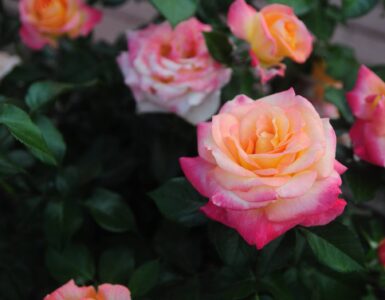Darin Engh, from Engh Gardens shows us how plants and carols can make perfect partners.
Green gifts of the season accessorized with Christmas Carol Theme songs
“We Wish You a Merry Christmas”
Poinsettias
• When choosing a poinsettia, pick a plant with firm, undamaged leaves and brightly colored bracts-the modified leaves people call the “flowers”.
• Place your plants near a sunny window with at least six hours of bright, indirect light a day..
• Water plants when the soil is dry to the touch, once or twice a week. To keep the soil moist, put gravel in the plant saucer. This helps hold the moisture.
• Protect the plant from rapid temperature changes, such as those near outside doors, air ducts, appliances, and fireplaces. Keep at a constant temperature, generally near 55 degrees.
• Fertilize every week but avoid full strength liquid fertilizers.
‘Freedom Red’, a deep, true red that holds its color well.
‘Pink Peppermint’, with softly speckled peach/pink bracts.
‘Jingle Bells’, unusual for its light pink flecks on dark red bracts.
The holiday just wouldn’t seem complete without the vivid and velvety accents provided by poinsettias in bloom.
“Oh Christmas Tree”
Tiny Treasure- Norfolk Pine or Lemon Cypress
Decorated dwarf conifers are every bit as charming as their larger counterparts, typically dressed up in holiday finery.
“Hark the Herald Angels Sing”
Angel-wing Begonias
With painted leaves that come splashed with a rainbow of colors – including rosy red, silver, chocolate brown, sunset pink, and olive green – begonias are plants of awesome beauty that bring color and life to both home and garden. Can begonias are also called angel wing-types. These upright begonias send up thick stems dense with leaves of all shapes, the most popular being the feathered “angel wing” types. Flowers are their forte, with clusters in white, pink, red, salmon, or orange.
“Holly and The Ivy”
Green with Ivy
A familiar symbol in holiday traditions and folklore, ivy ties the garden package together with green ribbons.
For superstitious folk, it holds the promise of happiness in the coming year. Place an ivy leaf in a bowl of water on New Year’s Eve, and if it is still fresh on Twelfth Night, your happiness is assured, or so the story goes.
But ivy offers more than symbolism. A chameleon by nature, ivy takes the shape of whatever it disguises, twining energetically with suction-cupped aerial roots, it winds around the least support like a benevolent python.
Collectors of ivy love it for its enchanting leaf forms with a unique personality. Ivy admirers often describe its leaves by their shape: heart, fan, bird’s foot, and curly. The basic ivy leaf has three to five lobes in a pleasing shade of glossy green. Leaves range from large, such as Algerian ivies, to miniature, including ‘Dckfoot’ English Ivy. Ivy hues vary from yellow-green to eerie greenish black. Some hybrids sport a silvery, yellow, or reddish sheen or contrasting veins; others myriad of marbled green, gray, gold, and cream.
Indoors, ivies do so well that some people only think of them as houseplants. Ivies can live for years indoors or out. Generally, ivies prefer moist, humus-rich alkaline soil that is well drained. Water plants regularly, provide a balance fertilizer every few months. Mist frequently. Keep plants out of direct sunlight.
“I’ll be Home for Christmas”
Rosemary
Rosemary is the plant of friendship and remembrance.
“Jingle Bells, Jingle Bells”
Amaryllis
These easy-to-grow bulbs make great gifts for plant lovers.
Good things come in small packages. Inside a homely bulb no bigger than a grapefruit, clusters of spectacular flowers await liberation. Amaryllis can be counted on for generous bouquets of trumpet-shaped flowers each measuring up to 10 inches across on stems 15 to 25 inches high.
• Plant individually in pots six to eight inches wide, or in groups of three in larger containers; bulbs should fit snuggly, but without touching. Select pots with holes for drainage. Partly fill the pot with sterile potting soil and place the bulb on top. Add soil to within a half inch of the rim, leaving space for watering. Soil should cover two-thirds of the bulb, with “shoulders” left exposed.
• Place potted bulbs near a sunny window, water sparingly until growth begins, then keep the soil evenly moist but never soggy. Bloom will begin their dazzling show in about six weeks.
For more information, you can visit Engh Gardens in Sandy, or contact them online at www.enghgardens.com.















Add comment